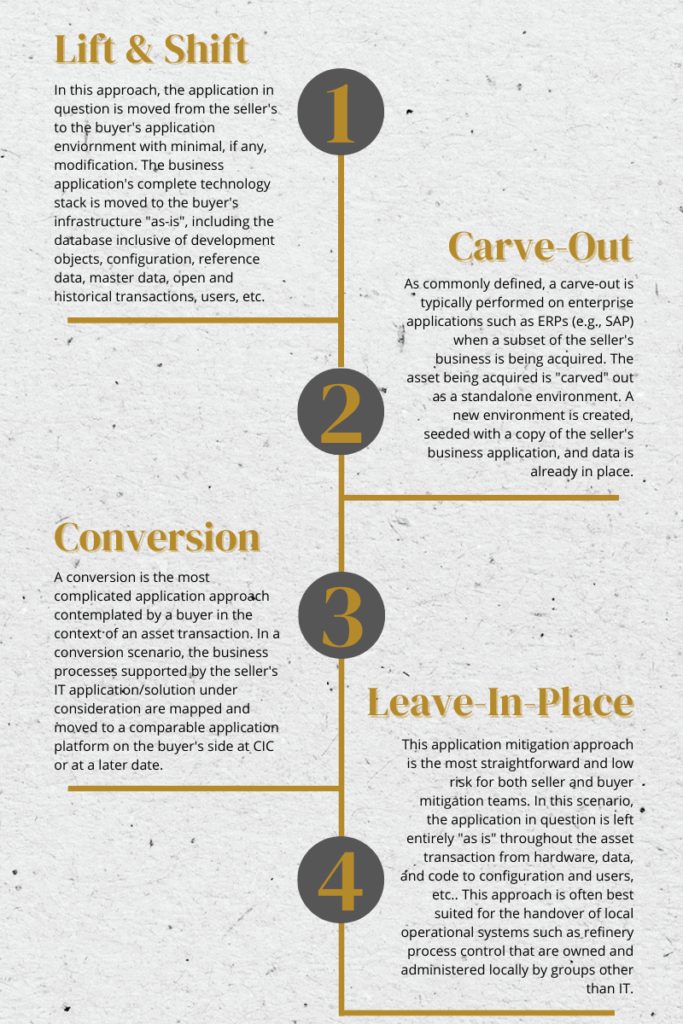Opportunities For Post-Acquisition Optimization

In almost every asset acquisition the primary focus is to transfer ownership with no interruption to operations. In the case of refinery acquisition, there’s little room for error as any change in operational status can result in significant cost and value loss. Leading up to the change in control (CIC), the seller and buyer need to agree on how IT capabilities that support the asset will be transitioned. In general, this will fall into four categories:

During post-ownership transfer and CIC, the focus shifts to capturing the value expected from the new asset. From the business to IT, there are several key areas to assess to achieve maximum value.
- Business Process Overlap
In many cases, the timeline from announcement to change in ownership is short, so only absolute critical business processes are integrated. This covers the operations of the asset itself and, generally, will include key HR processes. Once CIC happens, the business needs to be ready with a prioritized plan of process areas to integrate. From enterprise services like procurement and accounting to trading and scheduling/logistics, each area needs to have a plan with rationale supporting the prioritization. If some business areas were integrated at CIC, process owners need to be prepared to assess their areas after the first business period (month) to course-correct as needed and meet value capture targets.
Any manual processes in place at CIC to aggregate data (e.g., the roll-up of financials, risk/credit exposure, etc.) will need to be automated or eliminated as systems/tools are harmonized. In addition, any differences in business models for overlapping functions will need to be addressed.
- Carve-Out Integration
As described above, a common approach for the seller is to provide a “carve-out” IT system to support the core business processes of the asset. Depending on the timeline from announcement to CIC, it’s likely that most of the business processes supported by the carve-out system will remain in that system when ownership transfers. That can leave a substantial disconnect between core processes for the buyer—one set for the “legacy” assets and one set for the new asset. In addition to the complication of supporting two sets of processes, the carve-out system frequently comes in an isolated IT-hosted environment.
This can dramatically increase costs, which means integrating the carve-out business processes and supporting IT capabilities is a priority. This integration isn’t as easy as just converting the data over to the buyer’s applications. Performing this integration can be a full-time project as there’ll need to be training, data conversion, testing, and deployment.
- Application Rationalization
Regardless of the type of transition from seller to buyer, there’ll be many applications that need to transition at CIC. Application rationalization to realize cost savings is a key step in the integration plan, but one that is often oversimplified. Over time software licenses and contracts have become more and more complicated, requiring serious attention to ensure that users can continue using key applications when an asset changes hands. Then, after the initial transition occurs, the business and IT can look deeper at the contracts and licensing.
This involves going through each software contract, the business capabilities supported and determining the long-term plan. Once this is complete, either IT or procurement can approach selected vendors and notify them of cancelation, extension, or attempt to negotiate a buyout as applicable. Critical to this process is tracking each contract and paying attention to the details—this isn’t something that can be done at a high level as each contract will have nuances and timelines that must be monitored and acted upon.
- Capability Development
Rarely is an asset acquisition a simple “drag-and-drop” into an organization. Besides scale, there are always differences and nuances that make the asset unique. In many cases, either the addition of scale or those unique attributes can change or make the business case for developing a new capability to support and grow the business. Opportunities like this are often under appreciated in the initial scope of work post-transition, but they may be able to generate as much value as other business and application integration efforts. To take advantage of those new capabilities the business needs to clarify the strategic direction across the organization and then mobilize a team with the skills and authority to analyze and develop the necessary capabilities.
One example could be the acquisition of an asset with marine capabilities when the buyer’s existing assets have none. Leading up to and around CIC there may be temporary processes in place to manage marine movements, but ultimately a marine capability will need to be developed. This would include business processes for dock scheduling, vessel vetting, marine scheduling (and a lot more), as well as necessary IT capabilities to enable those new processes and IT to support those new capabilities. Those types of opportunities are identified early on with a comprehensive review of capabilities and assessment of the gaps.
CIC of a new acquisition is a huge undertaking, but post-acquisition integration is where value is delivered to the buyer. From business processes and capabilities to IT application integration and contracts, there’s significant work needed to optimize a successful integration.
Related Insights
Our experts are here
for you.
When you choose Opportune, you gain access to seasoned professionals who not only listen to your needs, but who will work hand in hand with you to achieve established goals. With a sense of urgency and a can-do mindset, we focus on taking the steps necessary to create a higher impact and achieve maximum results for your organization.
LeadershipGeneral Contact Form
Looking for expertise in the energy industry? We’ve got you covered.
Find out why the new landmark legislation should provide a much-needed boost for the development of carbon capture.




